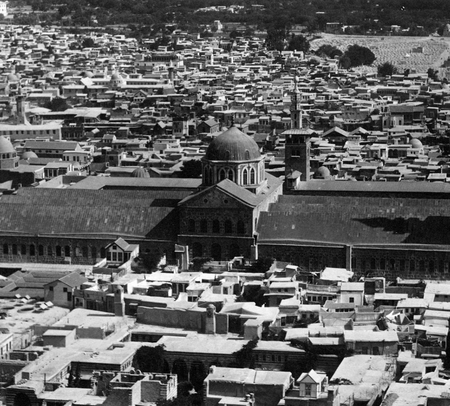Damascus: an oriental city

A masterpiece of Islamic architecture, the Umayyad mosque in Damascus was built to assert the power of the new regime - the first caliphs of the Islamic empire. It is famous for its elaborate marble and mosaic decorations.

Located in the centre of the city of Damascus, the great Umayyad mosque was founded by the caliph al-Walid I (r. 705-715) on acceding the throne. A masterpiece renowned both for its plan and its outstanding multicoloured mosaic decorations on a gold background, it has been continuously cared for by successive rulers down to the present-day, making it an exceptional example of early Islamic art.
The mosque stands on a site that bears witness to the city’s long and tumultuous history. Originally a temple dedicated to the god Hadad founded between the 10th and 9th century BCE, then a Greek temple dedicated to Jupiter, it was Romanised in the 1st century, and then Christianised in the 4th century following the construction of a church containing the relics of St John the Baptist in the enclosure. The mosque forms part of the sacred site and exists in harmony with the other religions: the relics of St John the Baptist are integrated into the Umayyad mosque and housed in a small marble aedicule. Its location also asserts the arrival of a new authority: the Umayyad dynasty.
From its foundation, the mosque was unanimously praised by visitors to Damascus: it is mentioned alongside the Kaaba in a 13th century Persian work called The Wonders of Creation
The building was constructed within the boundary of the ancient temple, on a basilica plan inherited from the architectural tradition of Late Antiquity. The mosque reasserts its continuity with the site while adapting the plan to the needs of Muslim worship. A qiblah wall and a mihrab were added and a large porticoed courtyard led to three long prayer rooms crossed at the centre by an axial nave with a high cupola.
The whole of the mosque was originally decorated over two levels. The lower part was faced with coloured veined marble in delicate geometric patterns, and the upper part consisted of a shimmering covering of multicoloured mosaic on a gold background. Some of these original decorations have survived, making this mosque an exceptional example of early Islamic art.
Learn more about the mosque of Damas and holy places by visiting the Bibliothèque d'Orient in the "Patrimoines partagés" collection coordinated by the Bibliothèque nationale de France.
Learn more :
Combating the theft and illicit trafficking of cultural property is one of the priorities of the French Ministry of Culture, which pays close attention to these issues, in line with its regulatory responsibility to control the movement of cultural property.